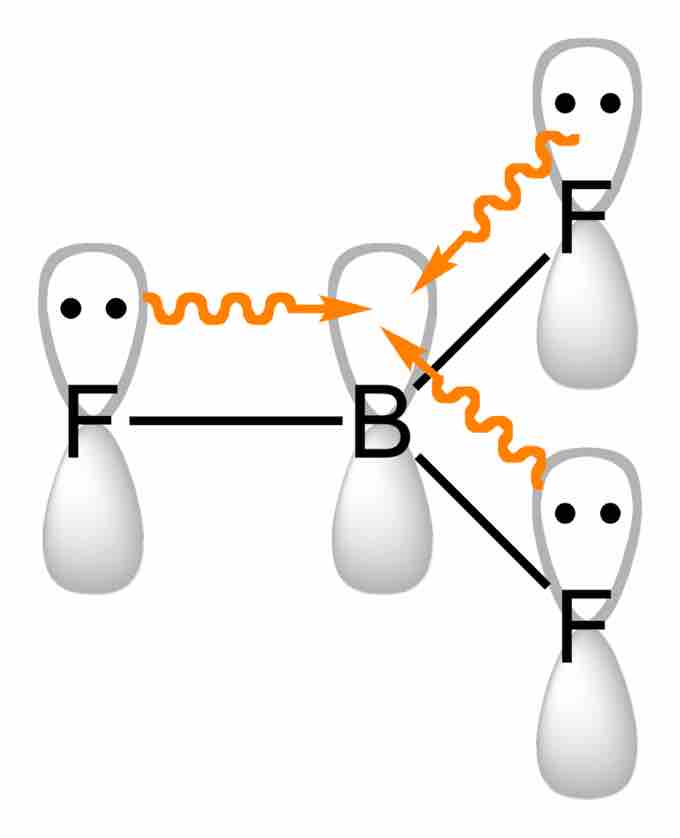Boron Halides
Boron undergoes halogenation to form trihalides with the molecular structure BX3, as in the following:
In its most familiar compounds, boron has the formal oxidation state III, or +3. These include oxides, sulfides, nitrides, and halides. The trihalides form planar trigonal structures and are Lewis acids because they readily form adducts with electron-pair donors, which are called Lewis bases. For example, fluoride (F-) and boron trifluoride (BF3) combine to give the tetrafluoroborate anion, BF4-. Boron trifluoride is used in the petrochemical industry as a catalyst.
The halides react with water to form boric acid:
where X can be Cl, Br, or I.
Lewis Acidity of Boron Halides
All three lighter boron trihalides, BX3 (X = F, Cl, Br), form stable adducts with common Lewis bases. Their relative Lewis acidities can be evaluated in terms of the relative exothermicities of the adduct-forming reaction. Such measurements have revealed the following sequence for the Lewis acidity: BF3 < BCl3 < BBr3 (in other words, BBr3 is the strongest Lewis acid).
This trend is commonly attributed to the degree of π-bonding in the planar boron trihalide that would be lost upon pyramidalization (the conversion of the trigonal planar geometry to a tetrahedral one) of the BX3 molecule, which follows this trend: BF3 > BCl3 > BBr3 (that is, BBr3 is the most easily pyramidalized). The criteria for evaluating the relative strength of π-bonding are not clear, however. One suggestion is that the F atom is small compared to the larger Cl and Br atoms, and the lone pair electron in the 2pz orbital of F is readily and easily donated, and overlaps with the empty 2pz orbital of boron. As a result, the

Boron trifluoride
Boron (III) trifluoride structure, BF3, showing the "empty" boron p orbital in pi-type coordinate covalent bonds.
Boron Tribromide
Boron tribromide (BBr3) is a colorless, fuming liquid compound that contains boron and bromine. The reaction of boron carbide with bromine at temperatures above 300 °C leads to the formation of boron tribromide. The product can be purified by vacuum distillation.
BBr3 is decomposed by water and alcohols. It is an excellent demethylating or dealkylating agent for the cleavage of ethers, also with subsequent cyclization (formation of cyclic molecules), often in the production of pharmaceuticals. The mechanism of ether dealkylation proceeds via the formation of a complex between the boron center and the ether oxygen followed by the elimination of an alkyl bromide to yield a dibromo(organo)borane. The dibromo(organo)borane can then undergo hydrolysis to give a hydroxyl group, boric acid, and hydrogen bromide as products. The electronics industry uses boron tribromide as a boron source in pre-deposition processes for doping in the manufacture of semiconductors.
Boron Trichloride
Boron trichloride (BCl3) is a colorless gas that is a valuable reagent in organic synthesis, but is also dangerously reactive. Boron trichloride is produced industrially by direct chlorination of boron oxide and carbon at 500 °C. The synthesis is analogous to the Kroll process for the conversion of titanium dioxide to titanium tetrachloride. In the laboratory, BF3 reacts with AlCl3 to create BCl3 via halogen exchange. Boron trichloride does not form dimers, although there is some evidence that may indicate dimerization at very low temperatures (20 K). NMR studies of mixtures of boron trihalides shows the presence of mixed halides, which may indicate a four center intermediate (that is, a dimer). The absence of dimerization contrasts with the other trihalides of group 13, which contain four or six coordinate metal centers.
Boron trichloride is a starting material for the production of elemental boron. It is also used in the refining of aluminium, magnesium, zinc, and copper alloys to remove nitrides, carbides, and oxides from molten metal. It has been used as a soldering flux for alloys of aluminium, iron, zinc, tungsten, and monel. Aluminum castings can be improved by treating the melt with boron trichloride vapors.
Boron Trifluoride
Boron trifluoride (BF3) is a pungent, colorless, toxic gas that forms white fumes in moist air. The molecule is isoelectronic with the carbonate anion, CO32−. BF3 is commonly referred to as "electron deficient" because of its exothermic reactivity toward Lewis bases. BF3 is manufactured by the reaction of boron oxides with hydrogen fluoride. Since boron trifluoride is corrosive, the metals suitable for handling boron trifluoride include stainless steel, monel, and hastelloy. In the presence of moisture, boron trifluoride corrodes stainless steel. Polytetrafluoroethylene, polychlorotrifluoroethylene, polyvinylidene fluoride, and polypropylene show satisfactory resistance.